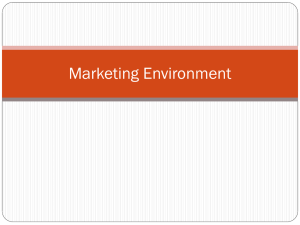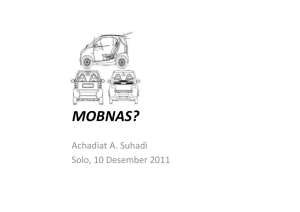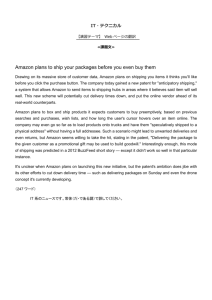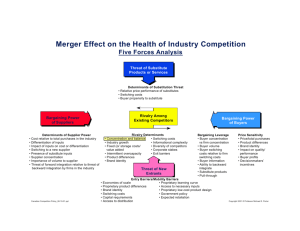Competitive Strategies
advertisement
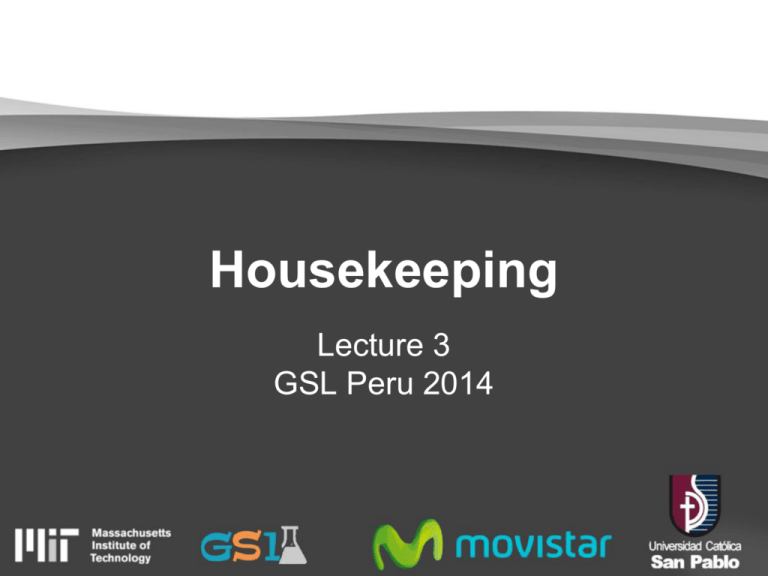
Housekeeping Lecture 3 GSL Peru 2014 Housekeeping ● Homework due Monday at beginning of class ○ Please submit printed copy ○ Individual work ● No more Coursesites ● GSL website - http://gsl.mit. edu/program/peru-summer-2014 ● No video recording ● Name Tag/Badges Question from Class How do you find that uncontested market space? “Blue Ocean Strategy” - W. Chan Kim and Renée Mauborgne Blue Ocean denotes all industry not in existence today Competitive Strategies Lecture 3 GSL Peru 2014 Porter’s Competitive Advantage ● Lower Cost ● Differentiated (Innovation) ● Focus Cost Leadership Strategy ● Focus on cost-conscious or price-sensitive customers ● Need to have lowest price or price to value ratio ● Must operate at lower cost than others ● Beware of competitive response and price war ● Product may become commoditized - hard to make profit Cost Leadership Strategy B Willingness to Pay (WTP) P Product Price to Buyer C PROFIT Increase P or Decrease C Product Cost to Seller Cost Leadership Strategy In order to succeed: ● High asset turnover - need large volume ○ economies of scale ○ learning curve advantage ● Lower operating costs ○ product standardization - no customization ○ fewer components ● Strict control over value chain ○ financing ○ suppliers Differentiation Strategy ● Product differentiation from competitors unique resources or capabilities ● Pick market segments who are not price sensitive in markets that are highly competitive or large number of players ● Can command premium Innovation S-curve Focus Strategy (Niche) ● “Focus” on narrow market segment with specialized needs ● Maybe combined with ○ cost leadership ■ Southwest Airlines ■ Family Dollar ○ or differentiation ■ Apple Macintosh Analyzing Competition Porter’s Five Forces Supplier Power - High ● ● ● ● ● Fewer supplier than buyers Buyer switching cost high Buyer not price sensitive Supplier can forward integerate Supplier owns customer Buyer Power - High ● ● ● ● ● Fewer buyers than suppliers Supplier switching cost high Customer price sensitive Buyer can backwards integerate Buyer owns customer Threat of New Entrants - High ● Low entry barrier ● Profitability does not require economies of scale ● Products are undifferentiated ● Brand names are not well-known ● Initial capital investment is low ● Consumer switching costs are low ● Accessing distribution channels is easy Threat of New Entrants - High ● ● ● ● ● Location is not an issue Proprietary technology is not an issue Proprietary materials is not an issue Government policy is not an issue Expected retaliation of existing firms is not an issue Threat of Substitutes - High ● Consumer switching costs are low ● Substitute product is cheaper than industry product ● Substitute product quality is equal or superior to industry product quality ● Substitute performance is equal or superior to industry product performance Threat of Rivalry - High ● ● ● ● ● ● Competitors are numerous Competitors have equal size Competitors have equal market share Industry growth is slow Fixed costs are high Products are undifferentiated Threat of Rivalry - High ● ● ● ● ● Brand loyalty is insignificant Consumer switching costs are low Competitors are strategically diverse There is excess production capacity Exit barriers are high Example: Amazon - Supplier Power ● Supplier power is low ● Amazon pays suppliers NET35 after item is purchased ● Suppliers want to be on Amazon ● Suppliers are fragmented ● Amazon owns customer Example: Amazon - Buyer Power ● Buyer power is low ● Customer are sticky ○ ease of use - 1 click ○ convenience ○ switching cost Example: Amazon - New Entrants ● A threat of new entrants is medium. ● While e-commerce sites can be easily setup, logistic and supply chain is not. Example: Amazon - Substitutes ● A threat of substitutes is medium ● Brick & Mortor stores (Target, Walmart) ○ sell at higher price ○ less convenient - have to go to store ● Online retailers (Target, Walmart) ○ Switching Cost Example: Amazon - Rivalry ● Many Brick & Mortors have online presence ● Sizes are comparable ● Amazon has differentiated product - books, Kindle ● Brand loyalty Competition - Key Factors ● Ownership and control of strategic resource ○ ○ ○ ○ ○ Cost Advantage Relationship Human capital Proprietary Technology Switching cost ● Differentiation ● Sustainability ● Statisfy customers Market Strategies Market Strategies Compete FOR the Market (You set the price) Compete IN the Market (Market sets the price) Enter EXISTING Market (Market sets the price) Enter/Create NEW Market (You set the price) Compete IN the Market ● ● ● ● ● Change nature of competition Bargaining and contracting Expansion via franchise Product variety (Attribute Space) Game Theory: Pricing, entry, reputation, information, … Compete FOR the Market ● ● ● ● ● Utilize network externalities Limit compatibility or connectivity Create/expand dominant network Licensing to become the standard Licesing to prevent entry Enter EXISTING Market ● ● ● ● ● Learn from experience of others Become a licensee (avoid innovation) Anticipate incumbent response Use alternative model of distribution Enter “empty” area of attribute space Enter/Create NEW Market ● ● ● ● Invent a new product/market Asses risk of failure Create market via licensing, joint venture Role of information and IT Total Addressible Market (TAM) Amount of annual revenue that the business would earn if you had 100% market share. Total Addressible Market (TAM) TAM ~= # of end user * $ revenue/end user/year For US based business, $20M-$100M is good target. Other strategies ● ● ● ● ● Multi-sided platforms/Network Externalities Big Data The Long Tail SaaS - Software as a Service - “Cloud” Gamification Network Externalities/Effects ● Good or service become more/less valuable when more people use it. Examples ● Telephones, Fax machine ● Twitter, Facebook ● Traffic Adopter Diffusion Model Moore’s Crossing the Chasm Different customer profile between early adopters and early majority. Multi-sided Platforms/Markets ● Market that connects disparate groups. ● Network Externalities - The value to each side grows as the size of the other group grows. ● The side that provides the value subsidizes the other. ● Sometimes both sides pays. iTunes Store ● Music Buyers + Music Publishers ● App Buyers + App Developers LinkedIn ● Professionals - manage identity, build professional network, search for job (free/paid) ● Recruiters - provide hiring solutions (paid) ● Content Providers - publish content and reach targeted audience (paid) ● Advertisers/Marketers - reach targeted audience (paid) ● Developers - integrate LinkedIn features (free) Taplister ● App that will help users find craft beers on tap by location. ● It also help bars and restaurant owners promote their beer selection nationwide in the U.S. ● Free for consumers, $99+ for businesses. Taplister Big Data ● A generic term for any big collection of data which cannot be processed in a traditional way. i.e. database queries, SAS prior to Big Data ● Also commonly associated with analytics or collecting, organizing/processing, and analyzing data. Big Data ● Companies collect huge amount of data regarding end users ● Google processes about 20 Petabytes/day (20,000 Terabytes/day) - 2008 ● The processing uses about $1M just in server hardware Big Data - Facebook ● Facebook collects 500 Terabytes./day (2012) ● 2.5 billion content items shared per day (status updates + wall posts + photos + videos + comments) ● 2.7 billion Likes per day ● 300 million photos uploaded per day ● 100+ petabytes of disk space in one of FB’s largest Hadoop (HDFS) clusters ● 105 terabytes of data scanned via Hive, Facebook’s Hadoop query language, every 30 minutes ● 70,000 queries executed on these databases per day http://www.visualnews. com/2012/06/19/how-much-data-createdevery-minute/ Data Analytics ● Finding meaningful information is large amount of unstructured data. ● Often used to describe/visualize, predict and improve business performance. ○ ○ ○ ○ Marketing Optimization Portfolio Optimization Risk Analysis Behaviorial Analysis Data Analytics - Nest Labs ● Home automation company with digital thermostats and smoke detectors ● Learning thermostat optimizes temperature based on heating and cooling habits of the people in the house Nest Labs Business Plan: ● Conserve and track consumer energy demands ● Energy companies are over capacity and do not have demand data are willing to pay for data. ● Nest provides a more accurate way to gather data around the usage patterns of their customer. The Long Tail ● 80/20 rule - 80% of the occurrence happens in the first 20% of the item distribution ● Amazon, Ebay, iTunes, Netflix Amazon ● Brick & Mortor stores have cost of storage and distribution. They only sell the popular items (1st 20%). ● With lower inventory and distribution costs, Amazon can sell obscure items in the tail (36.7% of sales) - Supply Side ● Recommendation Engine can push sales into the tail - Demand Side SaaS - Software as a Service Software license and delivery model where license is a subscription and access is centrally located. Also known as “on-demand software”, “cloud” Examples - Salesforce, LinkedIn, Dropbox Gamification ● Use of game thinking and mechanics in nongame context to engage users in problem solving. ● Leverages natural desire for competition, achieving goals, status, etc. ● Uses reward systems such as points, levels, virtual currency, etc. Gamification Examples Nike+ Loyalty Programs Key take aways Porter’s Competitive Advantage ● Lower Cost ● Differentiated (Innovation) ● Focus Key take aways Competition - Key Factors ● Ownership and control of strategic resource ○ ○ ○ ○ ○ Cost Advantage Relationship Human capital Proprietary Technology Switching cost ● Differentiation ● Sustainability ● Statisfy customers References ● Michael Porter ● 15.013 Industrial Economics - Robert Pyndick ● Disciplined Entrepreneurship - Bill Aulet


